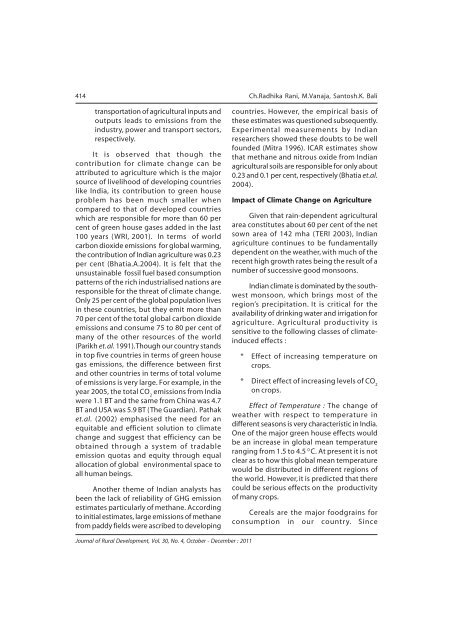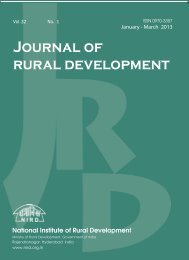Issue for October - December 2011 - National Institute of Rural ...
Issue for October - December 2011 - National Institute of Rural ...
Issue for October - December 2011 - National Institute of Rural ...
Create successful ePaper yourself
Turn your PDF publications into a flip-book with our unique Google optimized e-Paper software.
414 Ch.Radhika Rani, M.Vanaja, Santosh.K. Balitransportation <strong>of</strong> agricultural inputs andoutputs leads to emissions from theindustry, power and transport sectors,respectively.It is observed that though thecontribution <strong>for</strong> climate change can beattributed to agriculture which is the majorsource <strong>of</strong> livelihood <strong>of</strong> developing countrieslike India, its contribution to green houseproblem has been much smaller whencompared to that <strong>of</strong> developed countrieswhich are responsible <strong>for</strong> more than 60 percent <strong>of</strong> green house gases added in the last100 years (WRI, 2001). In terms <strong>of</strong> worldcarbon dioxide emissions <strong>for</strong> global warming,the contribution <strong>of</strong> Indian agriculture was 0.23per cent (Bhatia.A.2004). It is felt that theunsustainable fossil fuel based consumptionpatterns <strong>of</strong> the rich industrialised nations areresponsible <strong>for</strong> the threat <strong>of</strong> climate change.Only 25 per cent <strong>of</strong> the global population livesin these countries, but they emit more than70 per cent <strong>of</strong> the total global carbon dioxideemissions and consume 75 to 80 per cent <strong>of</strong>many <strong>of</strong> the other resources <strong>of</strong> the world(Parikh et. al. 1991). Though our country standsin top five countries in terms <strong>of</strong> green housegas emissions, the difference between firstand other countries in terms <strong>of</strong> total volume<strong>of</strong> emissions is very large. For example, in theyear 2005, the total CO 2emissions from Indiawere 1.1 BT and the same from China was 4.7BT and USA was 5.9 BT (The Guardian). Pathaket.al. (2002) emphasised the need <strong>for</strong> anequitable and efficient solution to climatechange and suggest that efficiency can beobtained through a system <strong>of</strong> tradableemission quotas and equity through equalallocation <strong>of</strong> global environmental space toall human beings.Another theme <strong>of</strong> Indian analysts hasbeen the lack <strong>of</strong> reliability <strong>of</strong> GHG emissionestimates particularly <strong>of</strong> methane. Accordingto initial estimates, large emissions <strong>of</strong> methanefrom paddy fields were ascribed to developingcountries. However, the empirical basis <strong>of</strong>these estimates was questioned subsequently.Experimental measurements by Indianresearchers showed these doubts to be wellfounded (Mitra 1996). ICAR estimates showthat methane and nitrous oxide from Indianagricultural soils are responsible <strong>for</strong> only about0.23 and 0.1 per cent, respectively (Bhatia et.al.2004).Impact <strong>of</strong> Climate Change on AgricultureGiven that rain-dependent agriculturalarea constitutes about 60 per cent <strong>of</strong> the netsown area <strong>of</strong> 142 mha (TERI 2003), Indianagriculture continues to be fundamentallydependent on the weather, with much <strong>of</strong> therecent high growth rates being the result <strong>of</strong> anumber <strong>of</strong> successive good monsoons.Indian climate is dominated by the southwestmonsoon, which brings most <strong>of</strong> theregion’s precipitation. It is critical <strong>for</strong> theavailability <strong>of</strong> drinking water and irrigation <strong>for</strong>agriculture. Agricultural productivity issensitive to the following classes <strong>of</strong> climateinducedeffects :* Effect <strong>of</strong> increasing temperature oncrops.* Direct effect <strong>of</strong> increasing levels <strong>of</strong> CO 2on crops.Effect <strong>of</strong> Temperature : The change <strong>of</strong>weather with respect to temperature indifferent seasons is very characteristic in India.One <strong>of</strong> the major green house effects wouldbe an increase in global mean temperatureranging from 1.5 to 4.5 0 C. At present it is notclear as to how this global mean temperaturewould be distributed in different regions <strong>of</strong>the world. However, it is predicted that therecould be serious effects on the productivity<strong>of</strong> many crops.Cereals are the major foodgrains <strong>for</strong>consumption in our country. SinceJournal <strong>of</strong> <strong>Rural</strong> Development, Vol. 30, No. 4, <strong>October</strong> - <strong>December</strong> : <strong>2011</strong>
















